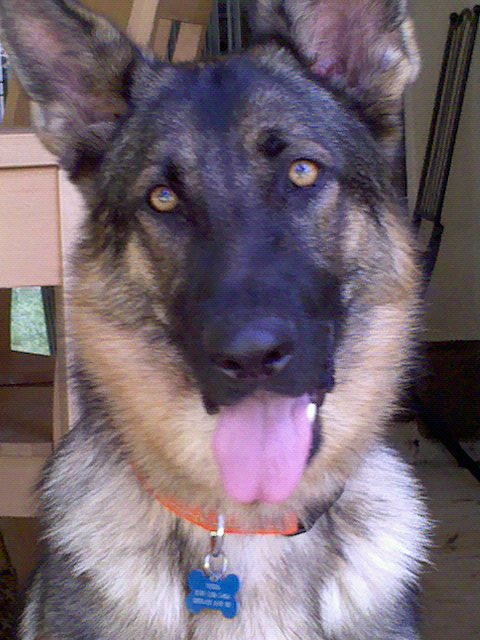Hey everyone! It's been a very long time since my last post. Ugh life can get so hectic sometimes, what I would not give for a few more hours in a day.
Anyway, I am going to start something new for awhile. I am going to be posting about feeding your dog a raw diet and y'all are going to be able to follow Voda and I through the process of learning the tricks of the trade! I have a few friends who are curious about this kind of diet and I would like to help in any way possible. So consider this Voda's way of giving back by allowing y'all to take the journey along with her! Are you excited maybe a little nervous? Well I know I definitely am!

Let me take a moment to explain the raw diet in my opinion and some info on what I have learned thus far. I'll start off with the dog's genealogy, dogs evolved from wolves. They share over 98% DNA. This leaves very little to be different. In my opinion this is where the domestic characteristics come into play; body and brain size, barking, coloring and marking differences, lop ears, etc... Most of these only being superficial. All the insides and their functions remain the same. Thus, allowing the dog to be able to eat like a wolf. Take a minute and look at your dog's teeth. What do you see? I can guarantee those teeth do not look like like a cow's teeth, so that would rule out herbivore. How about your teeth? Does you dog's teeth look anything remotely to human teeth? No? So that means dogs aren't omnivores. What a about a wolf's teeth or a tiger's? Do they look like multiple pairs of scissors interlocking with each other? YES, they do!! A dog's teeth were made to tear meat and meat alone. They are not for grinding grass, fruits, veggies, or kibble. Dog's are meat eaters. (I myself believe that wolves are opportunistic omnivores, but this in not an everyday practice among them. If prey is scarce wolves have been known to eat roots, berries, or fruits, but if you were starving I'm sure you wouldn't be too picky about what you ate either.) Why do you think dogs love to chew on sticks and anything else that they can sink their teeth into? It's because those jaws were made to break bones and to tear flesh. What part of a dog's anatomy benefits from kibble? Their jaws do not get a workout, which leads to boredom and frustration, and it also wears their teeth down from having to grind up "dog food" with teeth not built for grinding. And then you have to take in to consideration the allergic reactions that are becoming more and more prominent among kibble fed dogs. What is being put into the "dog food" that is making hundreds, if not thousands, of dogs sick? You will never know. Isn't that scary? This is what has caught my attention and caused me to make a change in what I feed my dog. I was feeding big name brand dog foods and spending a fortune just to have my dog vomit, have diarrhea, and have clumps of hair to fall out. If this was your child wouldn't you change what you are feeding them? In my case Voda is my fur child. And in my opinion feeding her a diet that is closer to her "roots" is best for her. Take same time and consider you dog's well-being, the amount of money you spend on their "food", and the possibility of changing to a more primal way of feeding.
Now on to same basic feeding rules and information that I am slowly becoming familiar with while learning how to feed raw.
#1. Take your dog's ideal adult weight...You want to feed 2-3% of that weight. This is just a guideline and may have to be adjusted according to your dog and it's activity level. The more energy burned equals the more food needing to be fed. Some dogs especially mothers can be feed up to 5% of their ideal body weight.
#2. The guideline is 80% muscle meat, 10% bone, 10% organ**half of the organ should be liver, as it contains many essential vitamins**.
#3. You usually want to start off with chicken because chicken is bland making it easy to digest and it's bones are very pliable. After your dogs has successfully adjusted to eating chicken slowly add new meats into their diets. Whether by adding chunks of new meat and subtracting the amount of chicken you are feeding or by introducing half of one day's meal as new meat and the other half as chicken, so as not to shock the body.
#4. Raw meals contain more water so do not be alarmed if your dog does not drink as much water as he/she did while eating kibble.
#5. Bowel movements will not be be as plentiful in number or size. ** A good rule of thumb to remember- Whitish or fossil-ish looking poos = too much bone, need to add more meat. Running poos = not enough bone/ too much meat.**
#6. Raw feeding is not expensive. There are so many different routes of getting meat cheaper than what you would expect. Go to butcher shops, meat processing plants, make friends with hunter, check out sales at the grocery store. I was spending $60-$80 for a 30lb bag of "dog food" now I pay maybe $1/lb.
There is plenty more to learn which means so much more that I will get to share with y'all. I hope you continue to read and follow along as Voda and I learn the ins and outs of Raw Feeding!
DAY 1 OF RAW EATING
On the menu: Chicken leg 1/4, chicken hearts, and chicken gizzards
















